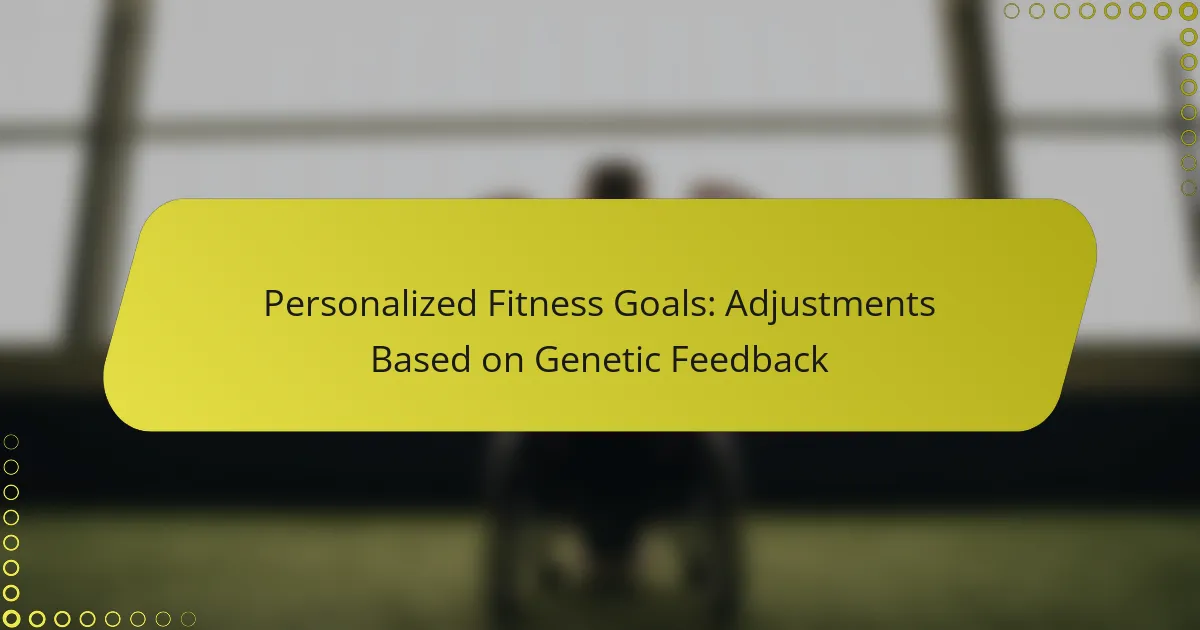Personalized DNA insights can significantly shape fitness goals by revealing genetic predispositions that influence physical performance and health. By understanding these factors, individuals can set realistic targets and develop tailored fitness plans that align with their unique biology, ultimately leading to more sustainable results.

How Can Personalized DNA Insights Shape Fitness Goals?
Personalized DNA insights can significantly shape fitness goals by providing information about genetic predispositions that affect physical performance and health. By understanding these genetic factors, individuals can set realistic targets and create effective fitness plans tailored to their unique biology.
Genetic predispositions influence fitness
Genetic predispositions play a crucial role in determining how individuals respond to exercise and diet. For instance, some people may have a genetic advantage in endurance sports, while others may excel in strength training due to their muscle fiber composition. Recognizing these traits can help set achievable fitness goals that align with one’s natural abilities.
To assess genetic predispositions, individuals can undergo DNA testing, which often reveals insights into metabolism, recovery rates, and injury risks. This information can guide the selection of appropriate fitness activities and help avoid overexertion or injury.
Tailored workout plans based on DNA
Creating tailored workout plans based on DNA insights involves customizing exercise routines to match genetic strengths and weaknesses. For example, someone with a genetic predisposition for power may benefit from high-intensity interval training (HIIT), while another individual might thrive with longer, steady-state cardio sessions.
When developing a personalized workout plan, consider factors such as recovery time and injury susceptibility indicated by genetic testing. Adjusting the frequency and intensity of workouts can lead to better results and a lower risk of burnout or injury.
Nutrition strategies aligned with genetic makeup
Nutrition strategies aligned with genetic makeup can enhance overall fitness and health. Genetic insights can inform dietary choices, such as macronutrient ratios or food sensitivities, allowing individuals to optimize their nutrition for performance and recovery. For instance, some may benefit from a higher carbohydrate intake, while others may thrive on a protein-rich diet.
To implement a nutrition strategy based on DNA insights, consider consulting with a nutritionist who can interpret genetic data and create a personalized meal plan. This approach can help ensure that dietary choices support fitness goals and overall well-being.

What Are Realistic Fitness Targets Based on Genetics?
Realistic fitness targets based on genetics are personalized goals that take into account an individual’s genetic predispositions, strengths, and weaknesses. These targets help in creating effective fitness plans that align with one’s unique biological makeup, making it easier to achieve sustainable results.
Setting achievable goals using genetic data
To set achievable fitness goals using genetic data, start by understanding your genetic profile, which can reveal insights about your metabolism, muscle composition, and recovery abilities. Use this information to tailor your exercise routine and dietary choices, ensuring they align with your genetic strengths.
Consider factors such as your potential for endurance versus strength training. For instance, if your genetic data suggests a predisposition for endurance, focus on longer cardio sessions rather than heavy weightlifting. Regularly reassess your progress and adjust your goals as needed to stay aligned with your evolving fitness journey.
Examples of DNA-based fitness targets
Examples of DNA-based fitness targets include specific performance metrics like running a 5K in under 25 minutes or increasing your squat weight by 10% over three months. These targets can be customized based on genetic insights, such as your VO2 max or muscle fiber type.
Another example is setting dietary goals that complement your genetic profile, such as increasing protein intake if your genetics indicate a higher need for muscle recovery. Aim for realistic milestones that can be achieved within a few weeks to months, ensuring they are both challenging and attainable based on your genetic insights.

How to Track Progress Towards DNA Fitness Goals?
Tracking progress towards DNA fitness goals involves using various tools and methods to measure changes in fitness levels and genetic insights. Regular assessments through fitness apps and genetic testing can provide valuable data to adjust your fitness plan effectively.
Using fitness apps for monitoring
Fitness apps are essential for tracking daily activities, workouts, and overall progress towards your DNA fitness goals. Many apps allow users to log exercises, monitor heart rate, and track caloric intake, providing a comprehensive view of fitness levels.
When selecting a fitness app, look for features that align with your specific goals, such as integration with wearable devices, personalized workout plans, and progress reports. Popular options include MyFitnessPal, Fitbit, and Strava, which cater to various fitness needs.
Regular genetic testing for updates
Regular genetic testing can help you stay informed about your body’s responses to exercise and nutrition, allowing for tailored adjustments to your fitness regimen. Tests can reveal insights into muscle composition, recovery rates, and potential injury risks.
Consider scheduling genetic tests every six months to a year, depending on your fitness goals and how quickly you want to adapt your training. Look for reputable labs that offer comprehensive reports, ensuring you have the most accurate and actionable information.

What Tools Are Available for Personalized DNA Fitness?
Several tools are available for personalized DNA fitness, allowing individuals to tailor their fitness goals based on genetic insights. These tools analyze genetic data to provide recommendations on exercise types, nutrition, and overall wellness strategies.
23andMe for genetic insights
23andMe offers genetic testing that provides insights into how your DNA may influence various health and fitness traits. This service analyzes specific genetic markers related to muscle composition, endurance, and recovery, helping users understand their predispositions.
When using 23andMe, consider the traits that are most relevant to your fitness goals. For instance, if you are focused on endurance sports, look for markers associated with aerobic capacity. The results can guide your training and nutrition strategies, making them more effective.
DNAfit for fitness recommendations
DNAfit specializes in translating genetic data into actionable fitness and nutrition plans. By analyzing your DNA, DNAfit provides personalized workout recommendations, dietary suggestions, and insights into recovery strategies tailored to your genetic profile.
To make the most of DNAfit, choose a plan that aligns with your fitness objectives, whether it’s weight loss, muscle gain, or improved endurance. The platform also offers ongoing support and updates based on your progress, ensuring that your fitness journey remains aligned with your genetic insights.

What Factors Influence the Effectiveness of DNA Fitness Plans?
The effectiveness of DNA fitness plans is influenced by various factors, including individual lifestyle choices and the consistency of training and diet. Understanding these elements can help tailor fitness goals that align with genetic insights for better results.
Individual lifestyle choices
Personal habits such as sleep patterns, stress management, and daily activity levels play a crucial role in the success of DNA fitness plans. For instance, individuals who prioritize quality sleep and manage stress effectively tend to see better fitness outcomes.
Moreover, dietary preferences and choices significantly impact how well one can adhere to a fitness regimen. A balanced diet rich in nutrients that support genetic predispositions can enhance performance and recovery.
Consistency in training and diet
Consistency is key when it comes to achieving fitness goals based on DNA insights. Regular workouts and adherence to a structured diet can lead to gradual improvements and help maintain motivation over time. Aim for a routine that includes both cardiovascular and strength training exercises.
It’s also important to track progress and adjust plans as needed. Setting realistic milestones, such as increasing workout frequency or improving dietary quality, can help maintain focus and commitment. Avoid drastic changes that can lead to burnout or injury.

How to Choose the Right DNA Fitness Service?
To choose the right DNA fitness service, consider the specific features, accuracy of genetic insights, and customer feedback. Look for services that provide comprehensive reports tailored to your fitness goals and lifestyle preferences.
Comparing features of leading services
When comparing DNA fitness services, focus on the range of features they offer. Key aspects include the depth of genetic analysis, the types of fitness recommendations provided, and any additional resources like meal plans or workout guides. Some services may offer personalized coaching, while others focus solely on genetic insights.
For example, services like 23andMe provide health and ancestry reports, while others like DNAfit concentrate on fitness-specific recommendations. Evaluate what aligns best with your fitness objectives and lifestyle.
Evaluating customer reviews and testimonials
Customer reviews and testimonials are essential for assessing the reliability of a DNA fitness service. Look for feedback on the accuracy of the insights provided and the effectiveness of the recommendations. High ratings and positive experiences can indicate a trustworthy service.
Pay attention to comments regarding customer support and the clarity of the reports. A service that offers responsive support and easy-to-understand results is often more beneficial for users looking to implement genetic insights into their fitness routines.

What Are the Milestones in Achieving DNA Fitness Goals?
Milestones in achieving DNA fitness goals are specific targets that help track progress based on genetic insights. These milestones can be categorized into short-term and long-term objectives, guiding individuals on their fitness journey.
Short-term vs long-term milestones
Short-term milestones typically focus on immediate, achievable goals that can be reached within weeks to a few months. Examples include committing to a new workout routine, improving dietary habits, or increasing daily physical activity. These targets provide quick feedback and motivation, helping to build momentum.
Long-term milestones, on the other hand, span several months to years and often involve more significant lifestyle changes. These could include achieving a specific fitness level, maintaining a healthy weight, or preparing for a fitness competition. Setting these broader goals helps maintain focus and commitment over time.
When setting both short-term and long-term milestones, consider your genetic predispositions and how they may influence your fitness journey. For instance, if your DNA suggests a higher propensity for endurance, you might prioritize long-distance running as a long-term goal while setting shorter milestones for weekly training sessions.



